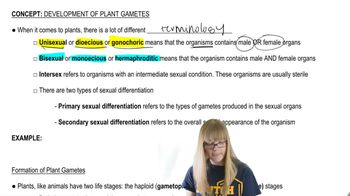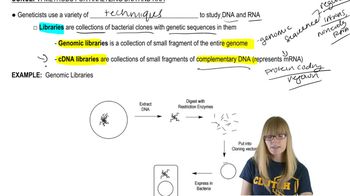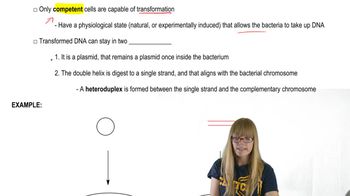Table of contents
- 1. Introduction to Genetics51m
- 2. Mendel's Laws of Inheritance3h 37m
- 3. Extensions to Mendelian Inheritance2h 41m
- 4. Genetic Mapping and Linkage2h 28m
- 5. Genetics of Bacteria and Viruses1h 21m
- 6. Chromosomal Variation1h 48m
- 7. DNA and Chromosome Structure56m
- 8. DNA Replication1h 10m
- 9. Mitosis and Meiosis1h 34m
- 10. Transcription1h 0m
- 11. Translation58m
- 12. Gene Regulation in Prokaryotes1h 19m
- 13. Gene Regulation in Eukaryotes44m
- 14. Genetic Control of Development44m
- 15. Genomes and Genomics1h 50m
- 16. Transposable Elements47m
- 17. Mutation, Repair, and Recombination1h 6m
- 18. Molecular Genetic Tools19m
- 19. Cancer Genetics29m
- 20. Quantitative Genetics1h 26m
- 21. Population Genetics50m
- 22. Evolutionary Genetics29m
18. Molecular Genetic Tools
Genetic Cloning
Problem 12
Textbook Question
Compare and contrast methods for making transgenic plants and transgenic Drosophila.
 Verified step by step guidance
Verified step by step guidance1
Step 1: Define what transgenic organisms are—organisms that have had foreign DNA introduced into their genome to express new traits—and explain that both transgenic plants and Drosophila are created to study gene function or improve traits.
Step 2: Describe common methods for making transgenic plants, such as Agrobacterium-mediated transformation, where the bacterium Agrobacterium tumefaciens transfers a gene of interest into plant cells, and biolistic (gene gun) methods, which physically deliver DNA into plant cells.
Step 3: Explain methods for making transgenic Drosophila, focusing on microinjection of DNA directly into early embryos, often using P-element transposons to integrate the foreign DNA into the fly genome.
Step 4: Compare the two approaches by highlighting that plant transformation often relies on bacterial vectors or physical delivery due to plant cell walls, while Drosophila transformation uses direct embryo injection and transposon-mediated integration because of the animal’s developmental biology.
Step 5: Contrast the efficiency, technical challenges, and typical applications of each method, noting that plant transformation can be slower and requires tissue culture, whereas Drosophila transformation is relatively rapid but limited to certain genomic insertion sites.
 Verified video answer for a similar problem:
Verified video answer for a similar problem:This video solution was recommended by our tutors as helpful for the problem above
Video duration:
1mPlay a video:
Was this helpful?
Key Concepts
Here are the essential concepts you must grasp in order to answer the question correctly.
Transgenic Plant Production Methods
Transgenic plants are commonly created using Agrobacterium-mediated transformation or biolistic (gene gun) methods. Agrobacterium transfers a DNA segment (T-DNA) into the plant genome, mainly effective in dicots, while biolistics physically delivers DNA into plant cells and can be used for monocots. Both methods require tissue culture to regenerate whole plants from transformed cells.
Recommended video:
Guided course

Plant Gamete Terminology
Transgenic Drosophila Production Methods
Transgenic Drosophila are typically generated by microinjecting DNA into early embryos, where the DNA integrates into the germline. Techniques include P-element mediated transformation, which uses transposons to insert DNA, and more recent methods like CRISPR/Cas9 for targeted genome editing. These methods allow stable inheritance of the transgene in fly populations.
Recommended video:
Guided course

Methods for Analyzing DNA and RNA
Comparison of Transformation Techniques
While both plants and Drosophila require DNA integration into the genome, plant methods often rely on bacterial vectors or physical delivery and tissue culture regeneration, whereas Drosophila methods involve direct embryo injection and transposon-mediated insertion. Differences arise from organism biology, such as cell wall presence in plants and developmental stages accessible for transformation.
Recommended video:
Guided course

Transformation
Related Videos
Related Practice
Textbook Question
Why are diseases of the blood simpler targets for treatment by gene therapy than are many other genetic diseases?
366
views


